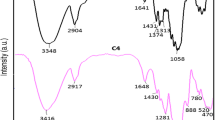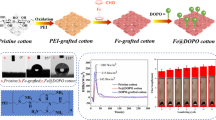Abstract
Environmentally-benign flame retardant cotton fabrics with hydrophobicity were fabricated using the bio-based flame retardant of phytic acid and n-Dodecyltrimethoxysilane successively, and then morphological structures, combustion behavior, thermal stability as well as hydrophobicity of cotton fabrics were investigated carefully. It is found that the prepared cotton fabric shows excellent flame retardant property during the combustion and can be extinguished immediately after ignition source is removed. The limited oxygen index of 27.4% can be reached, showing an improvement of 47.3% compared with that of virginal one. Furthermore, the cotton fabric ameliorates the color change problem. The contact angle of the cotton fabric is increased significantly up to 144.41°, and shows the excellent hydrophobicity to water, tea, milk, juice, coffee and cola. This study provided a facile approach to prepare environmentally-benign cotton fabrics with significant improved flame retardancy and excellent self-cleaning to various liquids.
Graphical abstract













Similar content being viewed by others
References
Alongi J, Carosio F, Malucelli G (2012) Influence of ammonium polyphosphate-/poly(acrylic acid)-based layer by layer architectures on the char formation in cotton, polyester and their blends. Polym Degrad Stab 97(9):1644–1653
Chang SC, Slopek RP, Condon B, Grunlan JC (2014) Surface coating for flame-retardant behavior of cotton fabric using a continuous layer-by-layer process. Ind Eng Chem Res 53(10):3805–3812
Chen DZ, Chen FX, Zhang HW, Yin XZ, Zhou YS (2016) Preparation and characterization of novel hydrophobic cellulose fabrics with polyvinylsilsesquioxane functional coatings. Cellulose 23(1):941–953
Chen DZ, Mai ZH, Liu X, Ye DZ, Zhang HW, Yin XZ, Zhou YS, Liu M, Xu WL (2018a) UV-blocking, superhydrophobic and robust cotton fabrics fabricated using polyvinylsilsesquioxane and nano-TiO2. Cellulose 25(6):3635–3647
Chen YB, Liu C, Zhang SL, Chen GQ, **ng TL (2018b) Combustion properties and thermal decomposition kinetics of flame retardant silk fabrics treated by phytic acid and silica sols. Therm Sci 22(4):1665–1671
Chen ZH, Dong CH, Li Q, Pu Y, Lu Z (2018c) Multifunctional, Hydrophobic and flame-retarded cotton fabrics modified with liner piperzine/phosphorous/polysiloxane copolymer. Fibers Polym 19(4):861–867
Cheng XW, Guan JP, Chen GQ, Yang XH, Tang RC (2016a) Adsorption and flame retardant properties of bio-based phytic acid on wool fabric. Polymers 8(4):122
Cheng XW, Guan JP, Tang RC, Liu KQ (2016b) Phytic acid as a bio-based phosphorus flame retardant for poly(lactic acid) nonwoven fabric. J Clean Prod 124:114–119
Cheng XW, Guan JP, Yang XH, Tang RC (2017) Improvement of flame retardancy of silk fabric by bio-based phytic acid, nano-TiO2, and polycarboxylic acid. Prog Org Coat 112:18–26
Cheng XW, Liang CX, Guan JP, Yang XH, Tang RC (2018) Flame retardant and hydrophobic properties of novel sol–gel derived phytic acid/silica hybrid organic–inorganic coatings for silk fabric. Appl Surf Sci 427:69–80
Costes L, Laoutid F, Brohez S, Delvosalle C, Dubois P (2017a) Phytic acid–lignin combination: a simple and efficient route for enhancing thermal and flame retardant properties of polylactide. Eur Polym J 94:270–285
Costes L, Laoutid F, Brohez S, Dubois P (2017b) Bio-based flame retardants: when nature meets fire protection. Mater Sci Eng R Rep 117:1–25
Daneluti ALM, Matos JDR (2013) Study of thermal behavior of phytic acid. Braz J Pharm Sci 49(2):275–283
Feng YJ, Zhou Y, Li DK, He S, Zhang FX, Zhang GX (2017) A plant-based reactive ammonium phytate for use as a flame-retardant for cotton fabric. Carbohydr Polym 175:636–644
Gao WW, Zhang GX, Zhang FX (2015) Enhancement of flame retardancy of cotton fabrics by grafting a novel organic phosphorous-based flame retardant. Cellulose 22(4):2787–2796
Gao X, Yan R, Xu L, Ma HY (2018) Effect of amorphous phytic acid nanoparticles on the corrosion mitigation performance and stability of sol–gel coatings on cold-rolled steel substrates. J Alloys Compd 747:747–754
Hijazi M, Stambouli V, Rieu M, Barnier V, Tournier G, Demes T, Viricelle JP, Pijolat C (2018) Synthesis and characterization of tin dioxide thick film modified by APTES in vapor and liquid phases. J Mater Sci 53(1):727–738
Jiang B, Chen ZX, Sun YL, Yang HW, Zhang HJ, Dou HZ, Zhang LH (2018) Fabrication of superhydrophobic cotton fabrics using crosslinking polymerization method. Appl Surf Sci 441:554–563
Khanjanzadeh H, Behrooz R, Bahramifar N, Gindl-Altmutter W, Bacher M, Edler M, Griesser T (2018) Surface chemical functionalization of cellulose nanocrystals by 3-aminopropyltriethoxysilane. Int J Biol Macromol 106:1288–1296
Laufer G, Kirkland C, Morgan AB, Grunlan JC (2012) Intumescent multilayer nanocoating, made with renewable polyelectrolytes, for flame-retardant cotton. Biomacromolecules 13(9):2843–2848
Li N, **a Y, Mao ZW, Wang L, Guan S, Zheng AN (2013) Synergistic effect of SiO2 on intumescent flame-retardant polypropylene. Polym Polym Compos 21(7):439–448
Li YZ, Wang BJ, Sui XF, **e RY, Xu H, Zhang LP, Zhong Y, Mao ZP (2018) Durable flame retardant and antibacterial finishing on cotton fabrics with cyclotriphosphazene/polydopamine/silver nanoparticles hybrid coatings. Appl Surf Sci 435:1337–1343
Lin DM, Zeng XG, Li HQ, Lai XJ, Wu TY (2019) One-pot fabrication of superhydrophobic and flame-retardant coatings on cotton fabrics via sol–gel reaction. J Colloid Interface Sci 533:198–206
Liu LX, Huang ZC, Pan Y, **n W, Lei S, Yuan H (2018a) Finishing of cotton fabrics by multi-layered coatings to improve their flame retardancy and water repellency. Cellulose 25(8):4791–4803
Liu XH, Zhang QY, Cheng BW, Ren YL, Zhang YG, Ding C (2018b) Durable flame retardant cellulosic fibers modified with novel, facile and efficient phytic acid-based finishing agent. Cellulose 25(1):799–811
Noh J, Kang I, Choi J, Fatima H, Yoo PJ, Oh KW, Park J (2016) Surface modification of magnesium hydroxide nanoparticles with hexylphosphoric acid to improve thermal stabilities of polyethylene composites. Polym Bull 73(10):2855–2866
Pan Y, Liu LX, Zhao HT (2018) Recyclable flame retardant paper made from layer-by-layer assembly of zinc coordinated multi-layered coatings. Cellulose 25(9):5309–5321
Przybylak M, Maciejewski H, Dutkiewicz A, Wesołek D, Władyka-Przybylak M (2016) Multifunctional, strongly hydrophobic and flame-retarded cotton fabrics modified with flame retardant agents and silicon compounds. Polym Degrad Stab 128:55–64
Ren GN, Song YM, Li XM, Wang B, Zhou YL, Wang YY, Ge B, Zhu XT (2018) A simple way to an ultra-robust superhydrophobic fabric with mechanical stability, UV durability, and UV shielding property. J Colloid Interface Sci 522:57–62
Shariatinia Z, Javeri N, Shekarriz S (2015) Flame retardant cotton fibers produced using novel synthesized halogen-free phosphoramide nanoparticles. Carbohydr Polym 118:183–198
Shirgholami MA, Khalil-Abad MS, Khajavi R, Yazdanshenas ME (2011) Fabrication of superhydrophobic polymethylsilsesquioxane nanostructures on cotton textiles by a solution-immersion process. J Colloid Interface Sci 359(2):530–535
Suryaprabha T, Sethuraman MG (2018) Fabrication of superhydrophobic and enhanced flame retardant coatings over cotton fabric. Cellulose 25(5):3151–3161
Wang HX, Ding J, Xue YH, Wang XG, Lin T (2010) Superhydrophobic fabrics from hybrid silica sol–gel coatings: structural effect of precursors on wettability and washing durability. J Mater Res 25(7):1336–1343
Wang K, Liu PC, Ye YH, Li J, Zhao WB, Huang XH (2014) Fabrication of a novel laccase biosensor based on silica nanoparticles modified with phytic acid for sensitive detection of dopamine. Sens Actuators B Chem 197:292–299
Wang B, Lei BH, Tang YH, **ang D, Li H, Ma Q, Zhao CX, Li YT (2018) Facile fabrication of robust superhydrophobic cotton fabrics modified by polysiloxane nanowires for oil/water separation. J Coat Technol Res 15(3):611–621
Wei DD, Dong CH, Chen ZH, Liu J, Li Q, Lu Z (2019) A novel cyclic copolymer containing Si/P/N used as flame retardant and water repellent agent on cotton fabrics. J Appl Polym Sci 136(13):47280
Xue CH, Zhang L, Wei PB, Jia ST (2016) Fabrication of superhydrophobic cotton textiles with flame retardancy. Cellulose 23(2):1471–1480
Yang MP, Liu WQ, Jiang C, He S, **e YK, Wang ZF (2018) Fabrication of superhydrophobic cotton fabric with fluorinated TiO2 sol by a green and one-step sol–gel process. Carbohydr Polym 197:75–82
Yu M, Li PJ, Feng YF, Li QQ, Sun W, Quan M, Liu ZT, Sun JJ, Shi SQ, Gong YK (2018) Positive effect of polymeric silane-based water repellent agents on the durability of superhydrophobic fabrics. Appl Surf Sci 450:492–501
Zhang M, Wang CY (2013) Fabrication of cotton fabric with superhydrophobicity and flame retardancy. Carbohydr Polym 96(2):396–402
Zhang DQ, Williams BL, Shrestha SB, Nasir Z, Becher EM, Lofink BJ, Santos VH, Patel H, Peng XH, Sun LY (2017) Flame retardant and hydrophobic coatings on cotton fabrics via sol–gel and self-assembly techniques. J Colloid Interface Sci 505:892–899
Zhang XB, Zhou XY, Cheng XW, Tang RC (2018a) Phytic acid as an eco-friendly flame retardant for silk/wool blend: a comparative study with fluorotitanate and fluorozirconate. J Clean Prod 198:1044–1052
Zhang Y, Wang H, Yan BN, Zhang YW, Yin P, Shen GL, Yu RQ (2018b) A rapid and efficient strategy for creating super-hydrophobic coatings on various material substrates. J Mater Chem 18(37):4442–4449
Zhou CL, Chen ZD, Yang H, Hou K, Zeng XJ, Zheng YF, Cheng J (2017) Nature-inspired strategy toward superhydrophobic fabrics for versatile oil/water separation. ACS Appl Mater Interfaces 9(10):9184–9194
Zhu YJ, Chen G, Liu YQ (2006) Application and applicability of phytic acid and phytate in gas phase antirust paper. China Pulp Paper Ind 11:1007–9211 (in Chinese)
Acknowledgments
The authors gratefully acknowledge Anhui Provincial Natural Science Foundation (1908085J20), the National Natural Science Foundation of China (Nos. 51775001 and 51474009) and Leading Talents Project in Colleges and Universities of Anhui Province.
Author information
Authors and Affiliations
Corresponding authors
Ethics declarations
Conflict of interest
The authors declare that they have no conflict of interest.
Additional information
Publisher's Note
Springer Nature remains neutral with regard to jurisdictional claims in published maps and institutional affiliations.
Electronic supplementary material
Below is the link to the electronic supplementary material.
Video of F4 in vertical flame test (MP4 30755 kb)
Video of various liquid droplets rolling freely on F4 (MP4 10194 kb)
Rights and permissions
About this article
Cite this article
Nie, S., **, D., Yang, Jn. et al. Fabrication of environmentally-benign flame retardant cotton fabrics with hydrophobicity by a facile chemical modification. Cellulose 26, 5147–5158 (2019). https://doi.org/10.1007/s10570-019-02431-y
Received:
Accepted:
Published:
Issue Date:
DOI: https://doi.org/10.1007/s10570-019-02431-y




